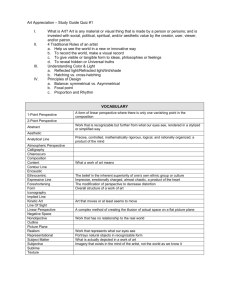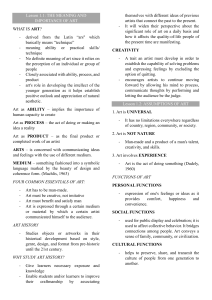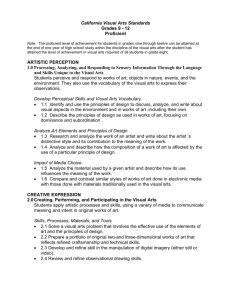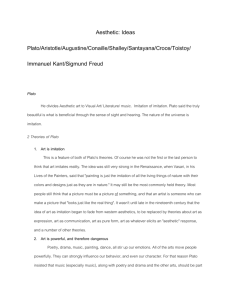4 Theories of Art PP
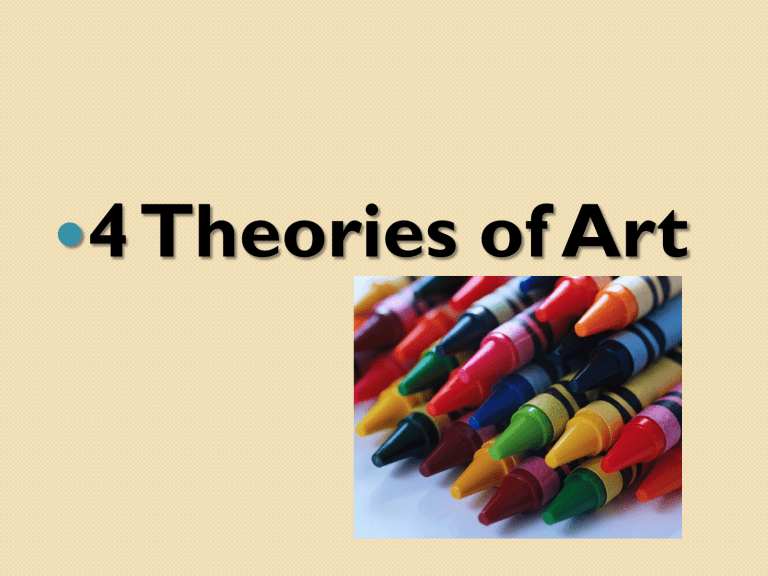
4 Theories of Art
4 Theories of Art
“Art is not a mirror to reflect reality, but a hammer with which to shape it” –Brecht
1. Imitation Theory
Imitation theories interpret art as either a literal mirror of “life” or else it draws upon and tries to clarify “life”. There is a close relationship between art and human experience outside of art. In defining fine art:
1. Imitation theory argues that fine art is a faithful, literal duplication of the objects or events of ordinary experience
2. It looks like and reminds us of what we know in reality apart from art
(e.g., simple imitation)
3. The value of the art-object depends upon the degree or its resemblance to the model – it is true to life
4. Fine art captures a characteristic or property shared by all members of
a certain class, by virtue of which they are members of that class;
5.Art ought to capture or depict events that are praiseworthy, and the value of art lies in its ability to imitate the ideal and communicate a moral message that brings about beneficial consequences.
2. Formalism Theory
The Formalist theory of art holds that true art is a world of its own, with no responsibility to copy or borrow from life. In defining fine art, this theory argues that:
1. Its purpose and values are uniquely its own;
2. The subject matter is of relatively slight importance in relation to what is intrinsic and peculiar to painting (i.e., line, mass, plane, colour, lighting) which is often abstract;
3. Emotionalist Theory
•The Emotionalist Theory,
1. Art is a record of human emotion and a vehicle for communicating it to others;
2. Artists should be under the influence of emotion and reveal the sincerity and individuality of the artist
3. Art should an expression of the artist’s personality;
4. Art does not have to “picture” beautiful things but can work with diverse subjects such as the exotic, macabre, or repulsive;
5. Spectators share in the emotion of the artist
Do not copy
(i.e., the spectator experiences the emotional force of the artist and says things like “this is what I felt”, “this art moves me”).
4. Aesthetic Fineness Theory
The theory of Aesthetic “Fineness”
1. Emphasizes its value for aesthetic perception as something splendid to perceive (i.e., attracts us aesthetically which can even include things in nature);
2. Should be judged solely on its intrinsic ability to produce aesthetic interest and perceptual appeal;
3. Does not necessarily depend on the artist’s purpose to produce such appeal;
4. Can be greatly appreciated even when it is not beautiful but bitter, gloomy, and heart-rending
5. Is catholic in its appreciation of the richness and complexity of all art forms.
MUSIC APPRECIATION
A. According to the 4 Theories which category does each piece of music fit into and why?
B. Which theory best suits your understanding of art and why?
Inner city blues Marvin Gaye
When I fall in love Chris Botti
DEC 4 th The Grey Album jay Z
Ain’t no sunshine
Massive Attack
Shuffering and Smiling RED Hot RIOT
OMIO Bambino Caro by Puccini

